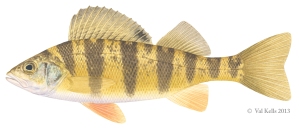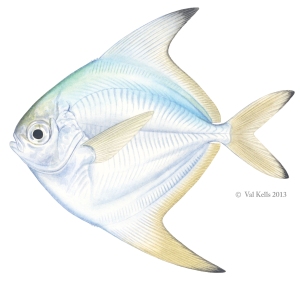
Johns Hopkins UniversityEst. 1876
America’s First Research University
Wild Thing: Q&A with the authors of "Field Guide to Fishes of the Chesapeake Bay"
Wild Thing is an occasional series where JHU Press authors write about the flora and fauna of the natural world—from the rarest flower to the most magnificent beast.
 The past spring, JHU Press published Field Guide to Fishes of the Chesapeake Bay. We sat down with this book’s authors, Edward O. Murdy and John A. (Jack) Musick, and its illustrator, Val Kells, to learn more about the aquatic life of the Chesapeake Bay.
The past spring, JHU Press published Field Guide to Fishes of the Chesapeake Bay. We sat down with this book’s authors, Edward O. Murdy and John A. (Jack) Musick, and its illustrator, Val Kells, to learn more about the aquatic life of the Chesapeake Bay.
JHUP: Val, because Chesapeake Bay fish are less colorful than tropical fish, are they harder to illustrate?
Val Kells (VK): No. Close up, fishes of the Chesapeake Bay are quite colorful, and as iridescent as tropical fishes. At a distance the iridescence isn’t so apparent. That said, their lack of apparent color doesn’t make them any less challenging to accurately illustrate. Some made me nuts! Each fish is a puzzle (no matter where it comes from). Once I figure out the puzzle, I spend as much time as needed to properly illustrate.
JHUP: Val, which was the hardest fish to paint and why?
VK: The most difficult subjects to illustrate are those that are rarely encountered or rarely documented. When this happens, I may spend as much time doing research as actual painting. I first turn to my huge library. Then, to the internet—including YouTube. I also dig into Biodiversity Heritage Library, which stores a huge database of species descriptions. If I’m still not confident with the reference I've gathered, I send queries to my large network of associates and post to Facebook, blogs, and forums. Armed with enough visual and written information I ‘Frankenstein’ the fish together and take great care to stay as true-to-life as possible.
JHUP: Ed, do fish migrate?
Edward O. Murdy (EOM): Depending on their feeding and spawning requirements, fishes may migrate between shallow and deep waters or between fresh and salt waters throughout the year. The Chesapeake Bay has examples of fishes that migrate between freshwater and saltwater (or vice versa) in order to reproduce. Anadromous fishes such as shads and herrings spend most of their adult lives at sea but migrate to freshwater to spawn. In the reverse direction, catadromous fishes such as the freshwater eel spend most of their adult lives in freshwater but migrate to the ocean to spawn. Most common Bay fishes are migratory. Only 15% are year-round residents, and some of these exhibit seasonal migrations within the Bay system.
JHUP: Are there eels in Chesapeake Bay?
EOM: Three different families of eels are reported from the Chesapeake Bay. The most common eel is the American eel, Anguilla rostrata, which is the only catadromous (i.e., migrates from freshwater to the sea to reproduce) fish in the Chesapeake Bay.
JHUP: What’s the smallest fish found in the Bay?
EOM: There are many small fishes in the Bay, such as killifishes, blennies, and gobies. The smallest may be the green goby (Microgobius thalassinus), which grows only to a little more than 1 1/2 inches.
JHUP: What are the most common fish found in the Bay?
EOM: The bay anchovy (Anchoa mitchilli) is the most abundant fish in the Chesapeake Bay. During the summer months, it can be found in many habitats from shallow to deep waters. The bay anchovy is a very important part of the diet of larger fishes such as flounder, bluefish, and striped bass. Fish-eating birds also prey upon the bay anchovy.
JHUP: Your editor, Vince Burke, has asked why people should care about Gobies.
EOM: This worldwide family of predominantly small fishes inhabits many different habitats, from mountain streams to estuaries to coral reefs to ocean depths exceeding 1,000 meters. There are more than 1,500 species of gobies, making it one of the largest families of fishes. Ichthyologists are still trying to understand why this fish family is so successful at adapting to a multitude of environmental conditions.
JHUP: What’s the largest fish found in our Bay?
John A. Musick (JAM): The Basking Shark, which attains lengths of 30-45 feet.
JHUP: Jack, tell us more about sharks in the Bay.
JAM: Several species of sharks have been reported from the mouth of the Chesapeake Bay, but their distribution is restricted by salinity. Three species—the Smooth Dogfish, Sand Tiger, and Sandbar Shark—occur commonly in the lower Bay but are generally restricted to salinities > 20 parts per thousand (usually south of the Pautuxent River). The Bay serves as the principle nursery and pupping area for the Sandbar Shark, the most important species in the Atlantic Large Coastal Shark Fishery. On rare occasions, the bullshark may penetrate into the upper Bay’s fresh water.
JHUP: Is there any fish in the Chesapeake that is on the rebound?
JAM: Several previously over-fished species are on the rebound because of new fishery management laws and better management by the Atlantic States Marine Fisheries Commission and the Mid-Atlantic Fishery Management Council. These species include but are not restricted to Summer Flounder, Black Seabass, and Spiny Dogfish.
JHUP: Which fish are in the most trouble?
JAM: Sandbar sharks underwent a severe decline because of over-fishing in the 1980s and 1990s, but have only partially recovered despite ever more stringent management measures by the National Marine Fisheries Service (NMFS). Also, the Atlantic Sturgeon was recently listed as Endangered by NMFS, because of coast-wide population collapses caused by historical over-fishing. Once spawning in large tributaries throughout the Bay, the species now has a spawning population only in the James River, where it recently has shown signs of recovery.
JHUP: What’s the most surprising thing you learned about these fish while working on Field Guide to the Fishes of the Chesapeake Bay?
VK: Hmmm. After the fact, I found that some folks are freaked out about the Snakehead, and others don't think it’s a big deal.
EOM: Sadly, after more than three decades and billions of dollars spent on clean-up efforts, the overall health of the Chesapeake Bay has not improved significantly since restoration efforts began. The Chesapeake Bay watershed continues to suffer from excess nutrients and sediment that enters its water as runoff from agricultural and residential lands and municipal discharges. As long as the Bay continues to have poor water quality and degraded habitats, the populations of many fish species will not return to historical levels.
Thursday, Sept. 26th, at 7:00 pm, Val Kells will speak at the Virginia Institute of Marine Science. Kells will give a behind-the-scenes talk about illustrating fishes that are both beautiful and scientifically accurate. Kells will sign her two books, Field Guide to Fishes of the Chesapeake Bay and A Field Guide to Coastal Fishes, following the talk. VIMS emeritus professor Jack Musick , co-author of Field Guide to Fishes of the Chesapeake Bay, will also be on hand to sign. Click here for further details and info.


